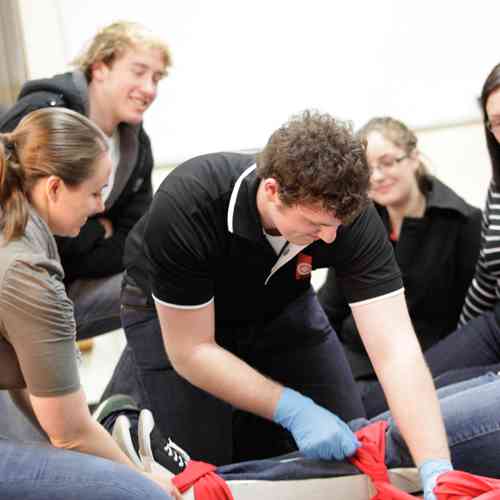Introduction
In today's fast-paced workplace, safety and security is extremely important. Organizations are progressively acknowledging the significance of creating a risk-free area for staff members. Among the most essential components of work environment security training is very first help and CPR (Cardiopulmonary Resuscitation) courses. These courses not just encourage employees with necessary life-saving abilities however likewise foster a society of safety and security within the organization. In this short article, we will delve into the myriad reasons that workplace safety and security training need to consist of first aid and CPR courses, emphasizing their relevance in boosting work environment safety.

Why Workplace Safety Training Need To Include Emergency Treatment and Mouth-to-mouth Resuscitation Courses
The assimilation of first aid and CPR courses into work environment security training has significant benefits. They outfit staff members with the understanding and skills essential to react successfully to medical emergency situations, lower recuperation time for injured people, and possibly save lives. Additionally, having actually educated personnel on-site can infuse confidence among workers and comfort them that their health is prioritized.
Understanding First Aid
First aid describes the immediate care offered to a private suffering from a minor or severe ailment or injury until expert clinical assistance arrives. Understanding standard first aid concepts can make a significant distinction in emergency situations.
Key Elements of First Aid
Assessment: The capability to assess a situation swiftly can aid establish the suitable actions needed. Stabilization: Recognizing how to support a hurt individual prevents more harm. Communication: Properly connecting with emergency services is important for timely assistance.The Significance of CPR
CPR is a life-saving technique made use of in emergencies when a person's heartbeat or breathing has quit. It entails breast compressions and rescue breaths to maintain blood flow and oxygenation until expert assistance arrives.
How CPR Works
- Chest Compressions: These help flow blood throughout the body. Rescue Breaths: These offer oxygen to the lungs.
Benefits of First Aid and Mouth-to-mouth Resuscitation Certification
Obtaining an emergency treatment certification or finishing mouth-to-mouth resuscitation training courses includes numerous benefits, both for individuals and organizations.
Enhanced Staff member Confidence: Staff members feel much more protected knowing they possess life-saving skills. Reduced Recovery Time: Quick reaction with first aid can cause better end results for hurt individuals. Compliance with Regulations: Lots of markets require licensed personnel as component of their health and safety regulations.Creating a Society of Safety And Security With Training
Implementing emergency treatment and CPR training fosters a society that focuses on worker well-being.
Encouraging Teamwork
Training sessions usually involve team-building exercises that improve collaboration among employees.
Building Trust Between Workers and Management
When administration invests in staff member training, it reveals commitment to their health, bring about increased morale.
First Help Surges vs. Mouth-to-mouth Resuscitation Courses: What's the Difference?
While both kinds of training courses are necessary, they concentrate on different ability sets.
First Aid Courses
These courses cover a vast array of subjects beyond simply heart emergencies, consisting of:


- Wound care Burns Choking
CPR Courses
CPR programs particularly focus on methods associated with cardiac arrest circumstances, highlighting:
- Adult CPR Child/ baby resuscitation Use of an Automated External Defibrillator (AED)
Choosing the Right Training Provider
Not all training companies are created equivalent; consequently, picking one that satisfies your organization's requirements is critical.
Accreditation Matters
Ensure that your selected supplier offers recognized courses recognized by appropriate authorities.
Instructor Experience
Consider trainers' qualifications; skilled instructors usually supply richer learning experiences through real-world examples.
Incorporating First Aid right into Workplace Safety And Security Policies
Organizations ought to integrate emergency treatment needs right into their more comprehensive safety and security plans for comprehensive coverage.
Regular Training Updates
Conducting routine refresher courses makes sure that expertise continues to be current among employees.
Creating Emergency Response Plans
Having clear plans in place can guide experienced personnel throughout emergencies.
Legal Effects of First Aid Training in the Workplace
Employers have legal obligations relating to workplace security; executing emergency treatment training can help reduce threats related to non-compliance.
Negligence Claims
Failure to supply adequate training might leave employers prone to lawsuits if an event happens because of absence of preparedness.
FAQ Section
What is included in a common emergency treatment course?- A typical first aid course includes instruction on assessing injuries, dealing with injuries, handling burns, taking care of choking incidents, and executing mouth-to-mouth resuscitation if necessary.
- Most CPR programs last between 4-- 6 hours depending on whether it's fundamental or advanced training.
- While not constantly lawfully mandated, having actually licensed personnel can significantly improve work environment security standards.
- Many approved organizations provide online revival options for first aid certificates that include analyses by means of video clip conferencing.
- Yes, industries such as construction, healthcare, education, and production typically have regulatory requirements requiring experienced employees on site.
- It's suggested that employees take part in refresher courses every two years or sooner if there are considerable adjustments in procedures or regulations.
Conclusion
To summarize, integrating emergency treatment and mouth-to-mouth resuscitation into office safety and security training is not merely an option yet a need in today's work environments where emergency situations can occur at any moment. Organizations advantage greatly from having trained employees prepared to respond efficiently during dilemmas while cultivating an environment where worker wellness takes priority over all else. Therefore, it becomes obvious why work environment safety training must consist of first aid and mouth-to-mouth resuscitation courses-- CPR course near Sydney CBD they conserve lives while promoting a positive approach toward health and wellness standards within organizations across various sectors.
By focusing on such essential training efforts-- emergency treatment certifications acquired via reliable suppliers alongside useful hands-on experience-- companies can considerably improve their overall emergency situation readiness levels while likewise constructing more powerful groups efficient in taking on any circumstance head-on!